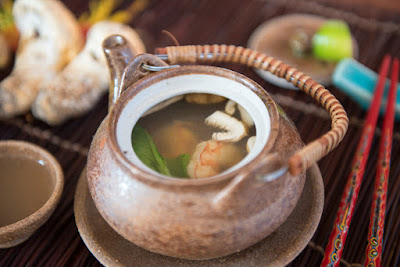These ceramic teapots are used to serve Matsutake Dobin Mushi, a favorite seasonal dish in Japan that relies on thinly sliced matsutake mushrooms to flavor a subtle broth as they steam in the pot. Other ingredients such as small pieces of chicken, fish, or shrimp along with a few thin slices of mild greens (e.g., yu choy, baby bok choy, or spinach) are also added. The teapot is served with a small upside-down cup fitted to the lid, with half a yuzu on top. The steaming broth is then poured into the cup with a squeeze of the citrus and sipped like tea, while the ingredients in the teapot are eaten with chopsticks. It's a ritualistic meal that evokes memories of brisk walks in the autumn woods as the leaves turn colors and fall to the ground.
You may see sources online suggesting the substitution of matsutake with shiitake, oyster, or cremini mushrooms. Certainly you can do that—but you won't be experiencing the ethereal and aromatic treat that only matsutke can provide and which the Japanese call "autumn aroma." As for the broth, think umami. I asked Taichi for some tips. He makes a kombu dashi and adds manila clams and black cod bones. Shrimp shells work, too. Avoid aromatics such as onion, carrot, and celery, he advised, because they will over-power the mushroom. Season the broth with sake, soy sauce, and sea salt. Lastly, it's important to allow the matsutake slices to steep in the broth and impart their hints of cinnamon, spice, and fungus. Taichi recommends gently warming the teapots with all their ingredients in a bamboo steamer rather than cooking directly over flame.
Matsutake mushrooms are pungent, with meaty texture—a little goes a long way. If you're buying matsutake in the market you'll be spending a frightening amount per pound (they were $70/lb at my local Japanese grocer the other day), but luckily you don't need a lot, so just get a small button to serve two. And if you can forage them yourself in the forest, all the better. Mine came from a patch not far from Seattle, where I found several pounds of prime buttons pushing up through the moss beneath a Douglas fir. At the time I was hunting chanterelles, but I'll remember this surprise of a spot and return to it next year.
Matsutake Dobin Mushi
Serves 2
2 cups kombu dashi (see below) 20 grams kombu 4 manila clams 4 shrimp, peeled (reserve shells) 1 tbsp sake 1/2 tsp soy 1/4 tsp salt 1 small to medium matsutake button, thinly sliced 6 bite-sized, thin-sliced pieces chicken breast (or white fish fillet such as cod, rockfish, halibut) 2 baby bok choy (or other mild green), halved 1 yuzu, halved (or 2 lime wedges) 1. Make kombu dashi ahead. Soak 20 grams of kombu (dried kelp) in a pot with 4 1/2 cups cold water for several hours or overnight. Bring nearly to boil before removing kombu with tongs. Boiling will turn the dashi bitter. Refrigerate dashi or continue to next step. 2. Heat 2 cups of kombu dashi in a pot with clams and shrimp shells. When the clams have opened, remove all shells. Season broth with sake, soy sauce, and sea salt. Simmer until alcohol has cooked off. 3. Divide equal portions of sliced matsutake, greens, shrimp, and chicken into dobin mushi pots, then add hot broth. Replace lids and heat teapots in a bamboo steamer over a kettle of boiling water for several minutes. (You can also steam in a wok with a rack and lid.) This gentle steaming allows the matsutake to fully infuse the broth while the shrimp, chicken, and greens poach. 4. Serve Dobin Mushi with a half of yuzu or lime wedge placed on top of each inverted cup. After removing the teapot lid, inhale the autumn aroma. Winter is on its way.













